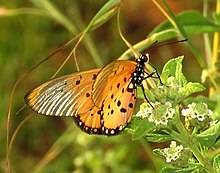Acraea neobule
| Acraea neobule | |
|---|---|

| |
| Acraea neobule subsp. neobule | |
| Scientific classification | |
| Domain: | Eukaryota |
| Kingdom: | Animalia |
| Phylum: | Arthropoda |
| Class: | Insecta |
| Order: | Lepidoptera |
| Family: | Nymphalidae |
| Genus: | Acraea |
| Species: | A. neobule |
| Binomial name | |
| Acraea neobule | |
| Synonyms | |
| |
Acraea neobule, the wandering donkey acraea, is a butterfly of the family Nymphalidae. It is found in Sub-Saharan Africa and south-western Arabia.
Description
A. neobule Dbl. and Hew. (53 f). Forewing above thinly scaled with light orange- yellow or ochre-yellow as far as the discal dots in 4 to 6 and in addition often at the distal margin in cellules 5 to 8, otherwise in the apical part hyaline; a spot beyond the middle of the cell, a transverse streak at the end of the cell and the discal dots often distinct, the discal dots in 2 and 3, however, not seldom wanting. Hindwing on both surfaces orange-yellow with distinct discal dots, of which the one in 4 is nearer to the distal margin than the rest; marginal band 1 to 1.5 mm. in breadth with rounded light marginal spots. Throughout South and East Africa to Angola, Zimbabwe, Sudan and Ethiopia.- seis Feisth. has the fore wing scaled wdth yellow in cellules 1 a to 2 as far as the distal margin and in cellules 3 to 8 distinct yellow marginal spots and consequently only in cellules 3 to 6 a hyaline subapical band; occasionally the yellow is replaced by black-grey or dark brown, especially in the female. Senegal to Nigeria, particularly in the interior. -zambesina Auriv. is very similar to neobule, but has the forewing completely scaled with red-yellow without diaphanous subapical area but with narrow marginal band 1 mm. in breadth, triangularly widened at the extremities of the veins; discal dots of both wings as in neobule) on the underside of the hindwing the white basal dots are smaller and of almost uniform size. Mozambique: Zumbo to the Zambezi River. -arabica Rbl. completely agrees above with the race seis, but differs from all the neobuleforms in having the basal dots on the underside of the hindwing smaller and placed quite free; marginal spots of the hind wing small and elongate almost as in horta. South Arabia[3]
The wingspan is 48–55 mm for males and 50–56 mm for females.
Subspecies
- Acraea neobule subsp. neobule
- Range: Senegal, Gambia, Guinea-Bissau, Guinea, Burkina-Faso, Liberia, Ivory Coast, Mali, Ghana, Togo, Benin, Niger, Nigeria, Cameroon, Equatorial Guinea, Gabon, Congo, Central African Republic, Angola, DRC, Sudan, Uganda, Kenya, Ethiopia, Somalia, Tanzania, Malawi, Zambia, Mozambique, Zimbabwe, Botswana, Namibia, South Africa, Eswatini, Lesotho, Saudi Arabia, Yemen, Oman
- Acraea neobule subsp. legrandi Carcasson, 1964
- Range: Seychelles
Biology
Adults are on the wing year round, but are more common from September to April.[4]
The larvae feed on Passiflora edulis, Passiflora incarnata, Adenia gummifera and Hybanthus species.
Taxonomy
It is a member of the Acraea terpsicore species group. But see also Pierre & Bernaud, 2014.[5]
References
- ^ Doubleday, E. in Doubleday, E. & Westwood, J.O. [1846-1852]. The genera of diurnal Lepidoptera 1: [xii], 1-250; 2: [ii], 251-534. London.
- ^ "Acraea Fabricius, 1807" at Markku Savela's Lepidoptera and Some Other Life Forms
- ^ Aurivillius, [P.O.]C. 1908-1924. In: Seitz, A. Die Grosschmetterlinge der Erde Band 13: Abt. 2, Die exotischen Grosschmetterlinge, Die afrikanischen Tagfalter, 1925, 613 Seiten, 80 Tafeln (The Macrolepidoptera of the World 13).Alfred Kernen Verlag, Stuttgart.
 This article incorporates text from this source, which is in the public domain.
This article incorporates text from this source, which is in the public domain.
- ^ Woodhall, Steve (2005). Field Guide to Butterflies of South Africa. Cape Town, South Africa: Struik. ISBN 978-1-86872-724-7.
- ^ Pierre & Bernau, 2014 Classification et Liste Synonymique des Taxons du Genre Acraea pdf
External links
- Images representing Acraea neobule at Bold
- Images representing Acraea neobule neobule at Bold
- Acraea neobule Archived 2020-01-27 at the Wayback Machine at Pteron
